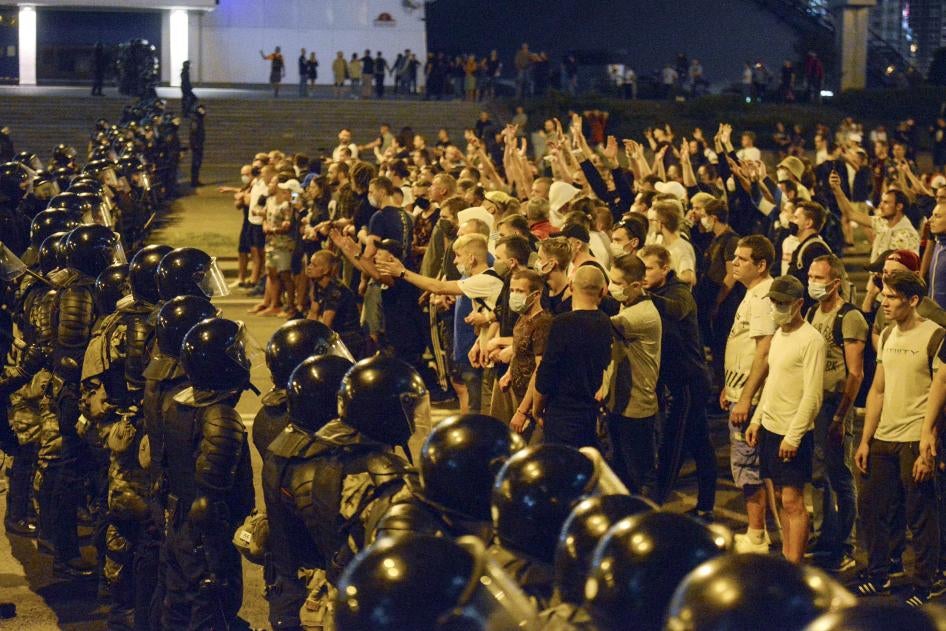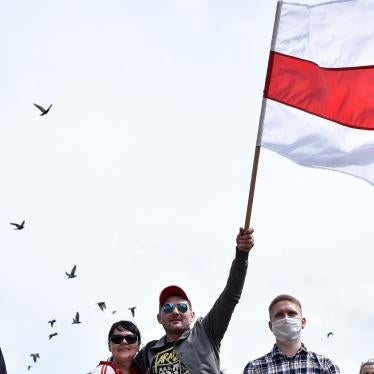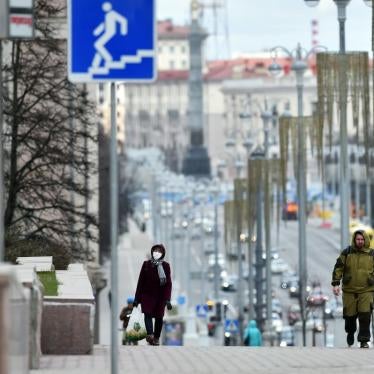(Berlin) – Belarus security forces viciously beat and detained largely peaceful protesters over the country’s election outcome on August 9 and 10, 2020, Human Rights Watch said today. The security forces variously used stun grenades, rubber bullets and slugs, blanks from Kalashnikov-type rifles, and tear gas against the large numbers of people who gathered in Minsk and several other Belarusian cities to protest the official election results in the country’s August 9 presidential vote, which they contend was rigged.
Belarus’ Central Election Commission claims that the incumbent, Alexander Lukashenka, won with 80 percent of the vote, with the main opposition candidate, Sviatlana Tsikhanouskaya, allegedly winning about 10 percent. The lead-up to the August 9 vote was marked by arrests of opposition political candidates and their supporters, bloggers, journalists, and peaceful protesters.
“Belarusian authorities have unleashed brute force in an effort to crush peaceful protests and stifle public discontent, said Hugh Williamson, Europe and Central Asia director at Human Rights Watch. “The response to the protests shows the country is on track for a new low point on human rights during Alexander Lukashenka’s 25-year rule.”
The authorities severely restricted access to the internet, which was wholly or partly unavailable on election day, for the third day in a row. Most mobile online communications platforms have been disabled, and many websites, including those of leading independent news sources, are blocked inside the country.
Most protests were peaceful. But several videos from the protests on August 10 appear to show some protesters throwing Molotov cocktails, setting off fireworks, and building barricades from overturned garbage dumpsters. A Human Rights Watch researcher observing developments in central Minsk did not see any incidents of protester violence. The researcher saw people being snatched up off the streets and arbitrarily detained where there was no protester violence and could hear the extensive use of stun grenades in Minsk late into the night of August 10.
An Interior Ministry spokeswoman on August 11 said that law enforcement had detained 2,000 people throughout Belarus the previous day. This appears to be in addition to the 3,000 people throughout Belarus who were detained during the night of August 9 to 10. She said that 21 law enforcement personnel had been injured, in addition to 39 injured overnight from August 9 to 10. The Health Ministry on August 11 stated that 200 people had been hospitalized due to injuries they sustained during the protest.
Police should immediately stop using excessive force and should respect the fundamental rights of Belarusians, including to freedom of expression, peaceful assembly, liberty, and security. The authorities should immediately investigate police use of force and release anyone detained as they protested peacefully.
The United Nations special rapporteur on Belarus should urgently investigate the post-election violence and provide urgent, public updates and recommendations for action in terms of protection and accountability in response to the escalating government crackdown and grave human rights violations.
Among those detained were numerous journalists. The Belarusian Association of Journalists estimated late on August 10 that at least 17 reporters had been detained or were reported missing on the night of August 9 to 10. The number has fluctuated since then, as some appear to have been released on August 11 while some others were detained. Maxim Solopov, a reporter for the Russian media outlet Meduza, went missing for 40 hours after being detained and beaten while covering a protest on August 10, before he was found in custody and handed over to the Russian embassy.
On August 10, a Human Rights Watch researcher in Minsk observed police vans in central Minsk, moving slowly down a main thoroughfare, stopping to let officers out to detain people seemingly at random. Riot police would leap out, chase mostly young adults, then catch them, twisting their arms, pushing their heads down, and dragging them into the van.
Numerous videos have appeared of police, sometimes in groups of two or three, beating someone they’ve kicked or pinned to the ground on the head and upper body with nightsticks. One video shot from outside a bus shows a riot officer inside beating someone with a nightstick. In another, police drag a woman out of her car by her hair.
Various media outlets reported that the police used stun grenades, tear gas, and rubber bullets on August 9 and 10 against people who were not engaging in violence. In Minsk, on August 10, a Human Rights Watch researcher could see stun grenade flashes around crowds of people who appeared to be doing nothing more than milling around peacefully on the street.
Reports suggest intense police use of stun grenades at the Pushkin Metro Station and the Riga Shopping Center outside the center or Minsk. A Human Rights Watch researcher who visited that site on August 11 found rubber bullets, casings, and tear gas cannisters, evidencing their use about 200 to 300 meters from the station. Pieces of sidewalk were smashed, possibly by protesters, and the researcher found what appeared to be used casings from blank cartridges. A man who was at the site on the night of August 10 to 11 told Human Rights Watch that the police were shooting blanks to scare the crowd. While they contain no projectile, blank cartridges may still cause injuries if fired at close range.
Riot police fired rubber bullets and stun grenades at people gathered at another Minsk shopping center, the Korona, wounding Natalia Lubnevskaya, a journalist with Nasha Niva, in the leg. It is unclear if the police were responding to any provocation by protesters.
Police also used stun grenades against protesters in other cities, including Brest, media and crowd-sourced platforms reported.
Around nightfall on August 10, some protesters in Minsk set off fireworks, angry at security forces’ previous use of stun grenades throughout the city.
At least one protester died from injuries sustained during the protests, apparently caused by either a stun grenade or other explosive device. The Interior Ministry claimed that the protester, who appeared to be inside a bus at the Pushkin Metro Station when he was injured, had tried to throw the explosive device at police, but that the device exploded and fatally wounded him.
A photograph of the deceased, viewed by Human Rights Watch, did not show any injuries to his hands, however. A statement by Belarusian human rights groups said that the protester was a “victim of the clashes,” though neither what caused his injuries nor the circumstances in which he sustained them were clear. The same statement expressed concern about “serious injuries suffered by civilians by stun grenades and rubber bullets, which were used on the streets of Minsk and other cities without good reason.”
On August 10, the Investigative Committee, Belarus’s criminal investigation service, stated that it had opened a criminal investigation into mass rioting, use of force against police, and other crimes, and that 80 people, most of them between the ages of 20 and 25, had been detained as suspects. No investigation has been opened into allegations of abusive police conduct.
Security forces should not fire stun grenades directly into crowds. Although the grenades are technically non-lethal, their fragmentation can foreseeably cause serious injuries in an indiscriminate manner, exposing nonviolent protesters and onlookers to grave harm. Polystyrene in some stun grenades will melt in the heat created when they are discharged and cause serious burns.
The police should also exercise the utmost restraint in using rubber “rocket” slugs and rounds of large rubber pellets, both of which can penetrate skin and bones and cause grave injuries. They can be lethal if fired at close range or toward softer body parts, such as the abdomen, chest, or head. Reports suggest that police used 12-millimeter rubber bullets.
Law enforcement should always respect human rights standards on the use of force during police operations, including in dispersing both legal and illegal demonstrations. The UN Basic Principles on the Use of Force and Firearms by Law Enforcement Officials require police to use nonviolent means, such as demands to vacate an area, before resorting to force and firearms. Police should adhere to a principle of measured escalation of force. When using force, law enforcement officials shall exercise restraint and act proportionately to the threat posed, and seek to minimize damage and injury.
Respect for freedom of assembly requires governments to show a high tolerance for peaceful assembly, even assemblies that the authorities deem unsanctioned or illegal. Physical assaults, including punching, kicking, or using wooden truncheons on unarmed demonstrators and journalists, are never a legitimate use of force and violate the prohibition against torture and inhuman treatment.
The European Union and its member states should send a clear message to the government of Belarus, and members of the police and security forces, that those responsible for serious human rights violations, including attacks on peaceful protesters, disproportionate use of force, and torture, will be held accountable.
“Beating and arresting peaceful protesters only adds to concerns over the way the presidential election was conducted,” Williamson said. “The government should put an end to excessive force by security forces and open an impartial investigation into their actions.”









